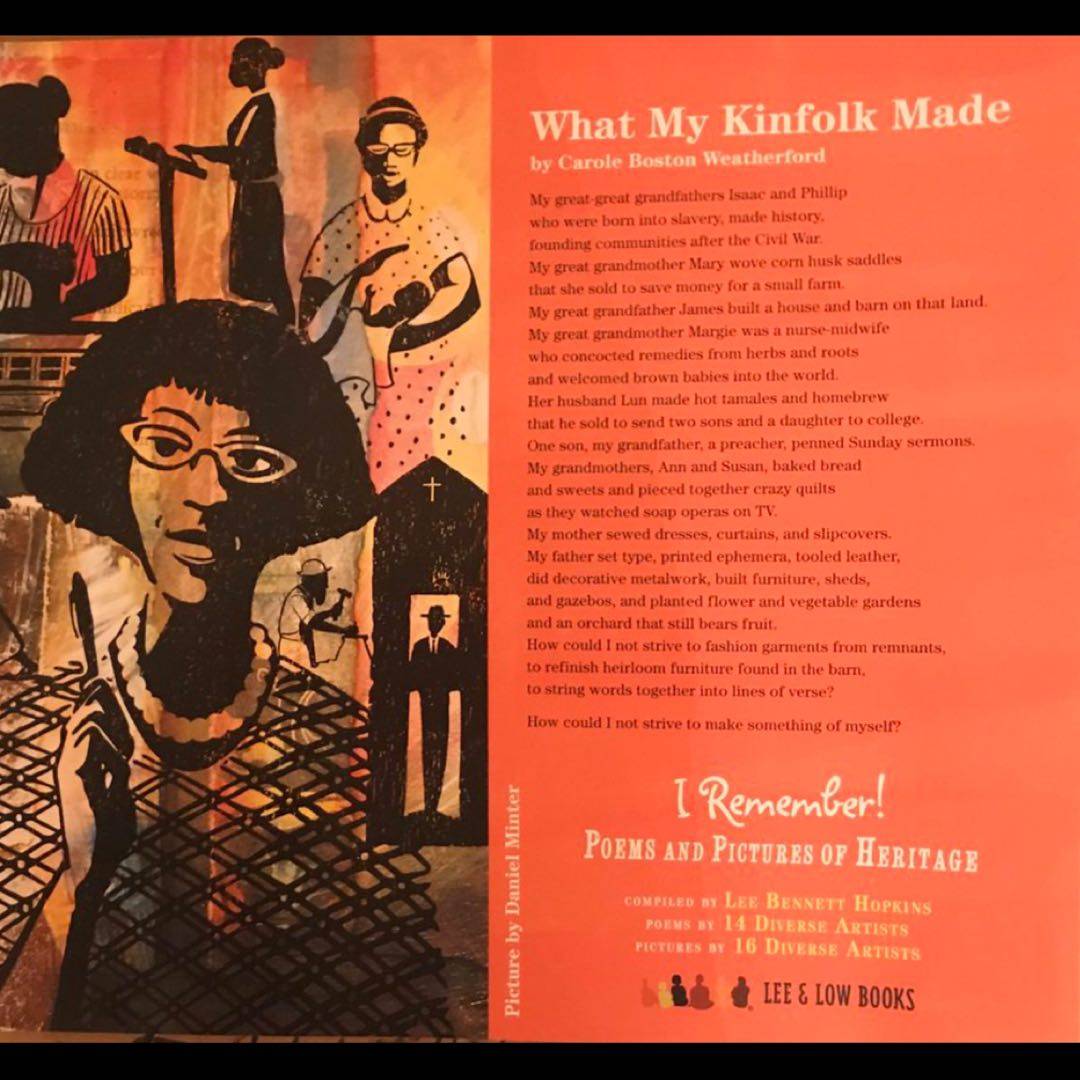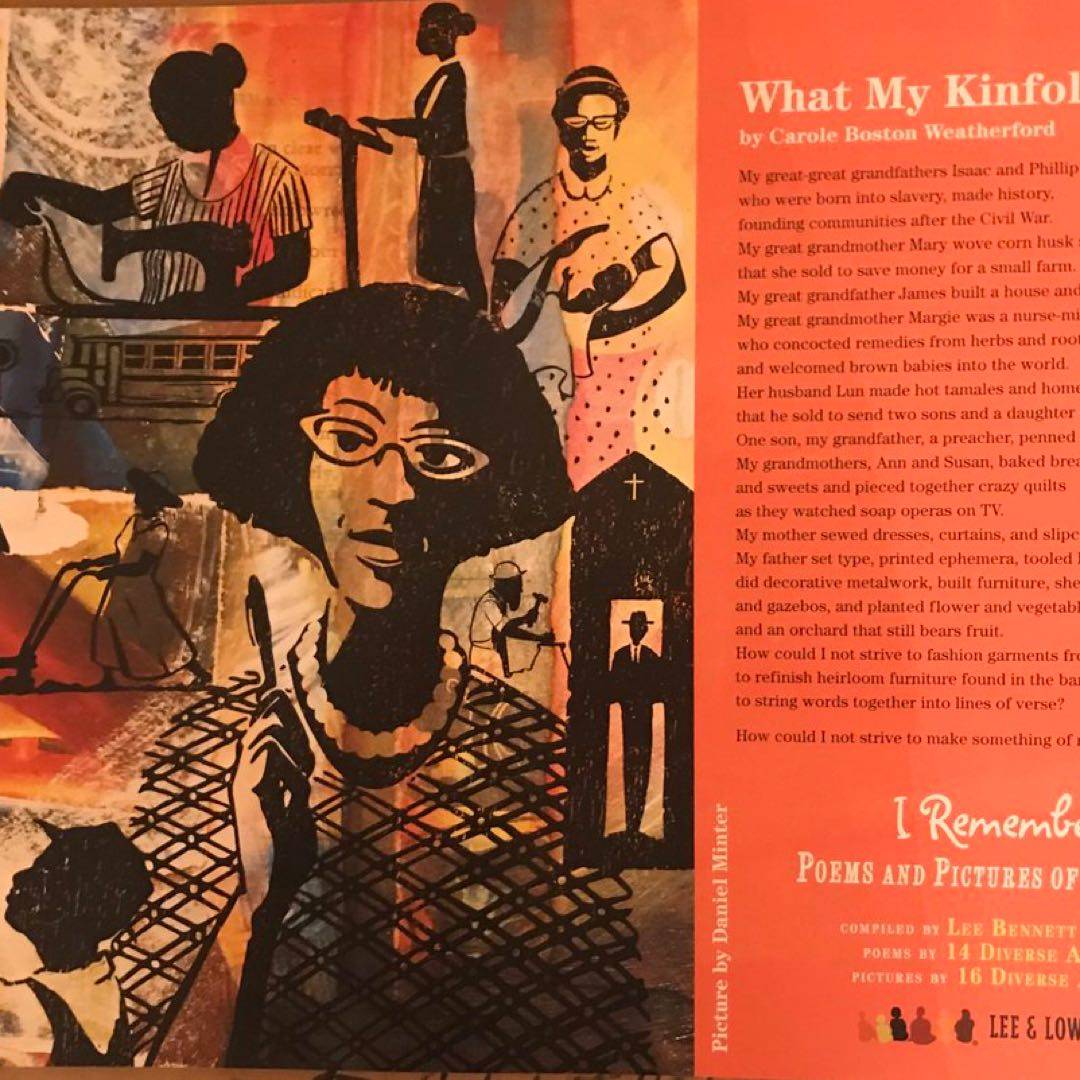“My grandpa was a sofer/ A scribe of Torah scrolls. With quill and ink on parchment. He finished rolls and rolls. From right to left the Hebrew flowed Without a single Flaw. And though Grandpa no longer lives His work leaves us in awe.“
“My grandpa was a sofer/ A scribe of Torah scrolls. With quill and ink on parchment. He finished rolls and rolls. From right to left the Hebrew flowed Without a single Flaw. And though Grandpa no longer lives His work leaves us in awe.“
I Remember: Poems and Pictures of Heritage is a collection of poems, and as such, it includes various sound patterns commonly found in poetry. Sound patterns in poetry add depth, rhythm, and musicality to the language, enhancing the overall reading experience.
“I Remember: Poems and Pictures of Heritage“ is a children's poetry book edited by Lee Bennett Hopkins. The book features a collection of poems and illustrations that celebrate and explore various aspects of cultural heritage, diversity, and family traditions. It is a tribute to the memories and experiences that people from different backgrounds carry with them throughout their lives.
“Sitting side by side, we embroider
colorful stitches on circles
of soft, dream-filled cloth.“
I think using poetry to dive deeper into everyone's heritage is a great way to teach students that everyone comes from somewhere different and depending on where that may be, it may look different for everyone. The elements of poetry that make it interesting is that you can really look at specifics and utilize the five senses.
This is a collection of poems relating to how beautiful everyone's heritage is and how it is important to celebrate it for everyone. One of the poems I focused on was called La Vista and it is about a young girl whose 'abuelita' comes to visit and they are able to celebrate the importance of what makes them unique.
“Sitting side by side, we embroider colorful stitches on circles of soft, dream-filled cloth.“
I would use this poem with older elementary students due to the details within the story. The author uses a plethora of complex language to describe her interaction with her grandmother. Identifying poetic aspects may take some guidance and support from the teacher. I would also use this book as a way for students to dive into a culture, experiences, and language they may not yet understand or appreciate.
“La Visita“ is a beautifully written poem about a young girl spending time with her Abuelita. The author states that this poem acts as a bridge between thoughts and feelings, between individuals, and between cultures. This poem does not use repetition or rhyme, rather focuses on rhythm and explicit details to tell the story and interaction between this young girl and her grandmother.
“My grandpa was a sofer/ A scribe of Torah scrolls. With quill and ink on parchment. He finished rolls and rolls. From right to left the Hebrew flowed Without a single Flaw. And though Grandpa no longer lives His work leaves us in awe.“
“I Remember: Poems and Pictures of Heritage“ is a collection of poems, and as such, it includes various sound patterns commonly found in poetry. Sound patterns in poetry add depth, rhythm, and musicality to the language, enhancing the overall reading experience.
“I Remember: Poems and Pictures of Heritage“ is a children's poetry book edited by Lee Bennett Hopkins. The book features a collection of poems and illustrations that celebrate and explore various aspects of cultural heritage, diversity, and family traditions. It is a tribute to the memories and experiences that people from different backgrounds carry with them throughout their lives.
“Today is special. Today you're fifteen. We are proud of you. TOday you are our queen“ This quote is about how a young girl is being celebrated because it is her quinceanera.
I enjoyed reading these poems. Each poem was different than the last and was very insightful to read about other's heritages. I think that this anthology would be great for all ages and especially good for students who want to learn more about other cultures.
This book is an anthology of poems that reflect different holidays, cultures, and heritages. The book shows many different authors and their poems reflect their culture and values. The types and rhythms of each of the poems are all different and are all set up differently. Some poems are free verse and some rhyme.
this book tells the beautiful story of people from different heritages through poetry
“How could I not strive to make something of myself?“
I thought that this was a great way to incorporate social studies and allow the students to think about their own history and past
What My Kinfolk Made, talked about how each family member made their mark on society and what legacies that they left.
I think these collection of poems taught a lot about diversity but could possibly get confusing for elementary students. I really enjoyed reading some of the poems but I think it‘s meant for older students

#FallMatters Day 17: For #ConstitutionDay, Weatherford‘s poem seems like the perfect fit:
“What My Kinfolk Made
My great-great grandfathers Isaac and Phillip
who were born into slavery, made history,
founding communities after the Civil War.
My great grandmother Mary wove corn husk saddles
that she sold to save money for a small farm.
My great grandfather James built a house and barn on that land.”
Fats‘ feature: https://wp.me/pDlzr-lXv

#MagicalMay Day 3: Fats featured Carole Boston Weatherford‘s poem included in this poetry anthology by the late Lee Bennett Hopkins:
“My great grandmother Margie was a nurse-midwife
who concocted remedies from herbs and roots
and welcomed brown #babies into the world.
Her husband Lun made hot tamales and homebrew
that he sold to send two sons and a daughter to college.”
Full feature and poem here: https://wp.me/pDlzr-lXv